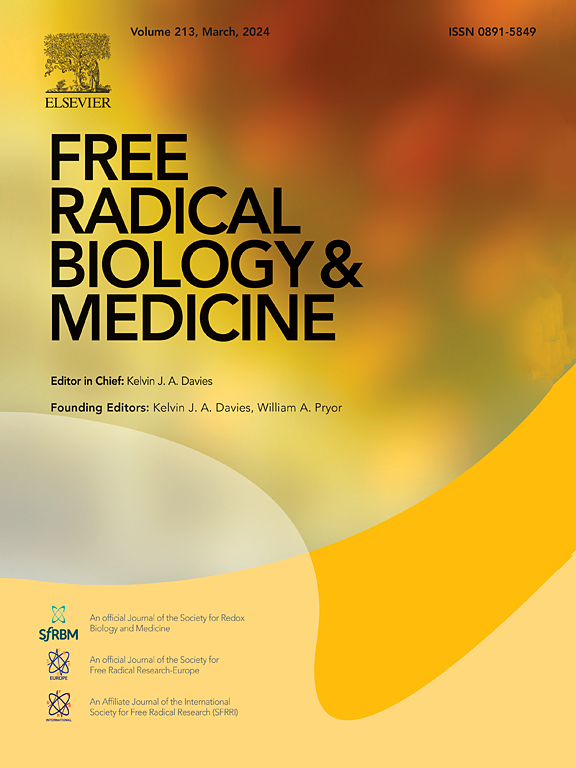Developing a physiologically relevant cell model of ferroptosis in cardiomyocytes
IF 7.1
2区 生物学
Q1 BIOCHEMISTRY & MOLECULAR BIOLOGY
引用次数: 0
Abstract
Excessive intracellular labile iron levels exacerbate reactive oxygen species (ROS) production through the Fenton reaction, leading to lipid peroxidation and ferroptotic cell death. Ferroptosis is commonly induced experimentally using chemical inhibitors such as RSL3 (a GPX4 inhibitor) or erastin (an inhibitor of the cystine-glutamate exchanger, Xc-) or by cysteine deprivation. However, these methods often fail to replicate the physiological complexity of ferroptosis and are associated with off-target effects. This study establishes a physiologically relevant model of ferroptosis in cardiomyocytes using ferric acetate (FAC) and tert-butyl hydroperoxide (TBH) to simulate iron overload and ROS generation. The combined application of FAC and TBH induced ferroptotic cell death, characterized by increased cytoplasmic Fe2+ levels, elevated lipid peroxidation, and a 2.5-fold rise in cell death, while FAC or TBH alone had minimal effects. Ferroptosis was confirmed by the complete prevention of cell death using ferrostatin-1 (a lipid peroxidation inhibitor) and ML351 (a 15-lipoxygenase inhibitor). Notably, this model bypasses the limitations of traditional synthetic inducers, such as off-target effects and inefficient mimicry of physiological conditions. Additionally, lipid peroxidation levels induced by the FAC-TBH combination were significantly higher than those induced by RSL3, further validating the relevance of this approach. These findings underscore the critical interplay between iron and ROS in ferroptotic cell death and highlight the utility of this model in advancing our understanding of ferroptosis mechanisms. This physiologically relevant system provides a robust platform for investigating therapeutic interventions targeting iron-induced oxidative stress and ferroptosis, particularly in conditions characterized by pathological iron accumulation, such as cardiomyopathies and ischemia-reperfusion injury. By focusing on the intrinsic drivers of ferroptosis, this work lays the groundwork for developing targeted treatments to mitigate ferroptosis-associated cellular damage.

建立心肌细胞铁下垂的生理相关细胞模型。
过量的细胞内不稳定铁水平通过芬顿反应加剧活性氧(ROS)的产生,导致脂质过氧化和铁致细胞死亡。在实验中,通常使用化学抑制剂如RSL3(一种GPX4抑制剂)或erastin(一种半胱氨酸-谷氨酸交换抑制剂,Xc-)或半胱氨酸剥夺诱导铁下沉。然而,这些方法往往不能复制铁下垂的生理复杂性,并与脱靶效应有关。本研究利用醋酸铁(FAC)和过氧化叔丁基(TBH)模拟铁超载和ROS生成,建立了心肌细胞铁凋亡的生理相关模型。FAC和TBH联合应用诱导铁致细胞死亡,其特征是胞质Fe2+水平升高,脂质过氧化水平升高,细胞死亡率增加2.5倍,而FAC或TBH单独使用的影响很小。通过使用铁抑素-1(一种脂质过氧化抑制剂)和ML351(一种15-脂氧合酶抑制剂)完全预防细胞死亡,证实了铁凋亡。值得注意的是,该模型绕过了传统合成诱导剂的局限性,例如脱靶效应和对生理条件的低效模仿。此外,facc - tbh联合诱导的脂质过氧化水平显著高于RSL3诱导的脂质过氧化水平,进一步验证了该方法的相关性。这些发现强调了铁和活性氧在铁细胞死亡中的关键相互作用,并强调了该模型在推进我们对铁细胞死亡机制的理解方面的实用性。这个生理相关系统为研究针对铁诱导的氧化应激和铁下沉的治疗干预提供了一个强大的平台,特别是在以病理性铁积累为特征的条件下,如心肌病和缺血再灌注损伤。通过关注铁下垂的内在驱动因素,这项工作为开发靶向治疗来减轻铁下垂相关的细胞损伤奠定了基础。
本文章由计算机程序翻译,如有差异,请以英文原文为准。
求助全文
约1分钟内获得全文
求助全文
来源期刊

Free Radical Biology and Medicine
医学-内分泌学与代谢
CiteScore
14.00
自引率
4.10%
发文量
850
审稿时长
22 days
期刊介绍:
Free Radical Biology and Medicine is a leading journal in the field of redox biology, which is the study of the role of reactive oxygen species (ROS) and other oxidizing agents in biological systems. The journal serves as a premier forum for publishing innovative and groundbreaking research that explores the redox biology of health and disease, covering a wide range of topics and disciplines. Free Radical Biology and Medicine also commissions Special Issues that highlight recent advances in both basic and clinical research, with a particular emphasis on the mechanisms underlying altered metabolism and redox signaling. These Special Issues aim to provide a focused platform for the latest research in the field, fostering collaboration and knowledge exchange among researchers and clinicians.
 求助内容:
求助内容: 应助结果提醒方式:
应助结果提醒方式:


